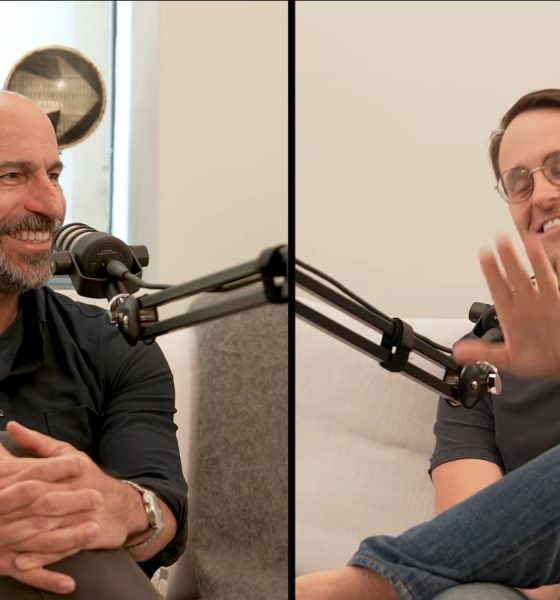The CEO of ride-sharing platform Uber has shared some of his doubts about Tesla’s ability to effectively execute robotaxi plans for its customers, pointing to the customer service side of the business as well as vehicle owner skepticism about letting strangers into their cars.
Tesla plans to launch a robotaxi platform in October, and CEO Elon Musk has talked at length over the years about hopes that such a platform could let owners’ vehicles work in a ride-sharing capacity while not in use, effectively making them money while driving themselves and ride-share passengers.
On Friday, Uber CEO Dara Khosrowshahi appeared on the Logan Bartlett Show on YouTube to discuss autonomous vehicles, during which he expressed more than a few doubts about Tesla’s robotaxi plans. For one, he says, peak ride-sharing times might coincide with the times owners want to use their own vehicles.
“Probably the times at which you’re going to want your Tesla are probably going to be the same times that ridership is going to be at a peak,” Khosrowshahi said during the interview.
He also notes that he doesn’t think society is prepared for self-driving vehicles, even if they are getting closer to goals of becoming safer than human drivers.
“Logic would dictate that if robots are twice as good a driver or three times as good as drivers as humans, that’s good for society going forward, but I honestly don’t know if society’s ready to accept that,” Khosrowshahi said.
The Uber CEO also talked about the business changes that Tesla would need to invest in to successfully build such a platform, and he noted how different he believes the ride-sharing and vehicle-building businesses really are.
“It’s a really, really different business you know, as well as talking about hardware, to build a $20,000 or $50,000 piece of hardware from driving over 30 million transactions every day that on a revenue basis you make $2 off of,” he added. “It’s just a very, very different business.”
Khosrowshahi also goes on to highlight the extra platforms that companies have to create to accommodate things that can go wrong in a ride-sharing vehicle, from people getting sick and wanting to pay with cash to those losing items in their ride-share, accidents, and more.
Unsurprisingly, he notes that it might be worthwhile for Tesla to partner with ride-sharing services like Uber in the future instead of developing its own, noting that he thinks the automaker could benefit from partnering with Uber.
“It’s taken us 15 years. It’s taken us tens of billions of dollars of capital, and we can provide that instantly to a partner,” Khosrowshahi added. “Hopefully, Tesla will be one of those partners.”
You can see the full interview with Uber CEO Dara Khosrowshahi below, as hosted by the Logan Bartlett show.
To be sure, Tesla has already teased a mobile platform it has been building for its robotaxi plans, and it has been developing its Full Self-Driving (FSD) Supervised for the past several years through testing and training from drivers that have purchased the software.
Other companies like Waymo and Cruise have also been working on their own driverless ride-hailing solutions, with the former already offering paid rides in select areas for the service. Despite this, Musk has previously highlighted that he thinks these companies will have a lot more trouble scaling these services, due to their requirements of high-density mapping of specific serviceable areas.
These, Musk says, are unlike FSD, which can theoretically be used just about anywhere due to its camera-based system and continuously-trained neural network. It’s worth noting that Tesla’s FSD still requires supervision, hence the name FSD “Supervised,” and it isn’t exactly clear just yet when the company expects to launch unsupervised versions of the software.
Although Tesla was originally supposed to hold its robotaxi unveiling event this month, Musk noted that the delayed event would allow the company to make some important changes and allow it to show off additional features.
“Requested what I think is an important design change to the front, and extra time allows us to show off a few other things,” Musk wrote in a post on X last month.
What are your thoughts? Let me know at zach@teslarati.com, find me on X at @zacharyvisconti, or send us tips at tips@teslarati.com.

News
Tesla FSD fleet is nearing 7 billion total miles, including 2.5 billion city miles
As can be seen on Tesla’s official FSD webpage, vehicles equipped with the system have now navigated over 6.99 billion miles.

Tesla’s Full Self-Driving (Supervised) fleet is closing in on almost 7 billion total miles driven, as per data posted by the company on its official FSD webpage.
These figures hint at the massive scale of data fueling Tesla’s rapid FSD improvements, which have been quite notable as of late.
FSD mileage milestones
As can be seen on Tesla’s official FSD webpage, vehicles equipped with the system have now navigated over 6.99 billion miles. Tesla owner and avid FSD tester Whole Mars Catalog also shared a screenshot indicating that from the nearly 7 billion miles traveled by the FSD fleet, more than 2.5 billion miles were driven inside cities.
City miles are particularly valuable for complex urban scenarios like unprotected turns, pedestrian interactions, and traffic lights. This is also the difference-maker for FSD, as only complex solutions, such as Waymo’s self-driving taxis, operate similarly on inner-city streets. And even then, incidents such as the San Francisco blackouts have proven challenging for sensor-rich vehicles like Waymos.
Tesla’s data edge
Tesla has a number of advantages in the autonomous vehicle sector, one of which is the size of its fleet and the number of vehicles training FSD on real-world roads. Tesla’s nearly 7 billion FSD miles then allow the company to roll out updates that make its vehicles behave like they are being driven by experienced drivers, even if they are operating on their own.
So notable are Tesla’s improvements to FSD that NVIDIA Director of Robotics Jim Fan, after experiencing FSD v14, noted that the system is the first AI that passes what he described as a “Physical Turing Test.”
“Despite knowing exactly how robot learning works, I still find it magical watching the steering wheel turn by itself. First it feels surreal, next it becomes routine. Then, like the smartphone, taking it away actively hurts. This is how humanity gets rewired and glued to god-like technologies,” Fan wrote in a post on X.
News
Tesla starts showing how FSD will change lives in Europe
Local officials tested the system on narrow country roads and were impressed by FSD’s smooth, human-like driving, with some calling the service a game-changer for everyday life in areas that are far from urban centers.

Tesla has launched Europe’s first public shuttle service using Full Self-Driving (Supervised) in the rural Eifelkreis Bitburg-Prüm region of Germany, demonstrating how the technology can restore independence and mobility for people who struggle with limited transport options.
Local officials tested the system on narrow country roads and were impressed by FSD’s smooth, human-like driving, with some calling the service a game-changer for everyday life in areas that are far from urban centers.
Officials see real impact on rural residents
Arzfeld Mayor Johannes Kuhl and District Administrator Andreas Kruppert personally tested the Tesla shuttle service. This allowed them to see just how well FSD navigated winding lanes and rural roads confidently. Kruppert said, “Autonomous driving sounds like science fiction to many, but we simply see here that it works totally well in rural regions too.” Kuhl, for his part, also noted that FSD “feels like a very experienced driver.”
The pilot complements the area’s “Citizen Bus” program, which provides on-demand rides for elderly residents who can no longer drive themselves. Tesla Europe shared a video of a demonstration of the service, highlighting how FSD gives people their freedom back, even in places where public transport is not as prevalent.
What the Ministry for Economic Affairs and Transport says
Rhineland-Palatinate’s Minister Daniela Schmitt supported the project, praising the collaboration that made this “first of its kind in Europe” possible. As per the ministry, the rural rollout for the service shows FSD’s potential beyond major cities, and it delivers tangible benefits like grocery runs, doctor visits, and social connections for isolated residents.
“Reliable and flexible mobility is especially vital in rural areas. With the launch of a shuttle service using self-driving vehicles (FSD supervised) by Tesla in the Eifelkreis Bitburg-Prüm, an innovative pilot project is now getting underway that complements local community bus services. It is the first project of its kind in Europe.
“The result is a real gain for rural mobility: greater accessibility, more flexibility and tangible benefits for everyday life. A strong signal for innovation, cooperation and future-oriented mobility beyond urban centers,” the ministry wrote in a LinkedIn post.
News
Tesla China quietly posts Robotaxi-related job listing
Tesla China is currently seeking a Low Voltage Electrical Engineer to work on circuit board design for the company’s autonomous vehicles.

Tesla has posted a new job listing in Shanghai explicitly tied to its Robotaxi program, fueling speculation that the company is preparing to launch its dedicated autonomous ride-hailing service in China.
As noted in the listing, Tesla China is currently seeking a Low Voltage Electrical Engineer to work on circuit board design for the company’s autonomous vehicles.
Robotaxi-specific role
The listing, which was shared on social media platform X by industry watcher @tslaming, suggested that Tesla China is looking to fill the role urgently. The job listing itself specifically mentions that the person hired for the role will be working on the Low Voltage Hardware team, which would design the circuit boards that would serve as the nervous system of the Robotaxi.
Key tasks for the role, as indicated in the job listing, include collaboration with PCB layout, firmware, mechanical, program management, and validation teams, among other responsibilities. The role is based in Shanghai.
China Robotaxi launch
China represents a massive potential market for robotaxis, with its dense urban centers and supportive policies in select cities. Tesla has limited permission to roll out FSD in the country, though despite this, its vehicles have been hailed as among the best in the market when it comes to autonomous features. So far, at least, it appears that China supports Tesla’s FSD and Robotaxi rollout.
This was hinted at in November, when Tesla brought the Cybercab to the 8th China International Import Expo (CIIE) in Shanghai, marking the first time that the autonomous two-seater was brought to the Asia-Pacific region. The vehicle, despite not having a release date in China, received a significant amount of interest among the event’s attendees.










